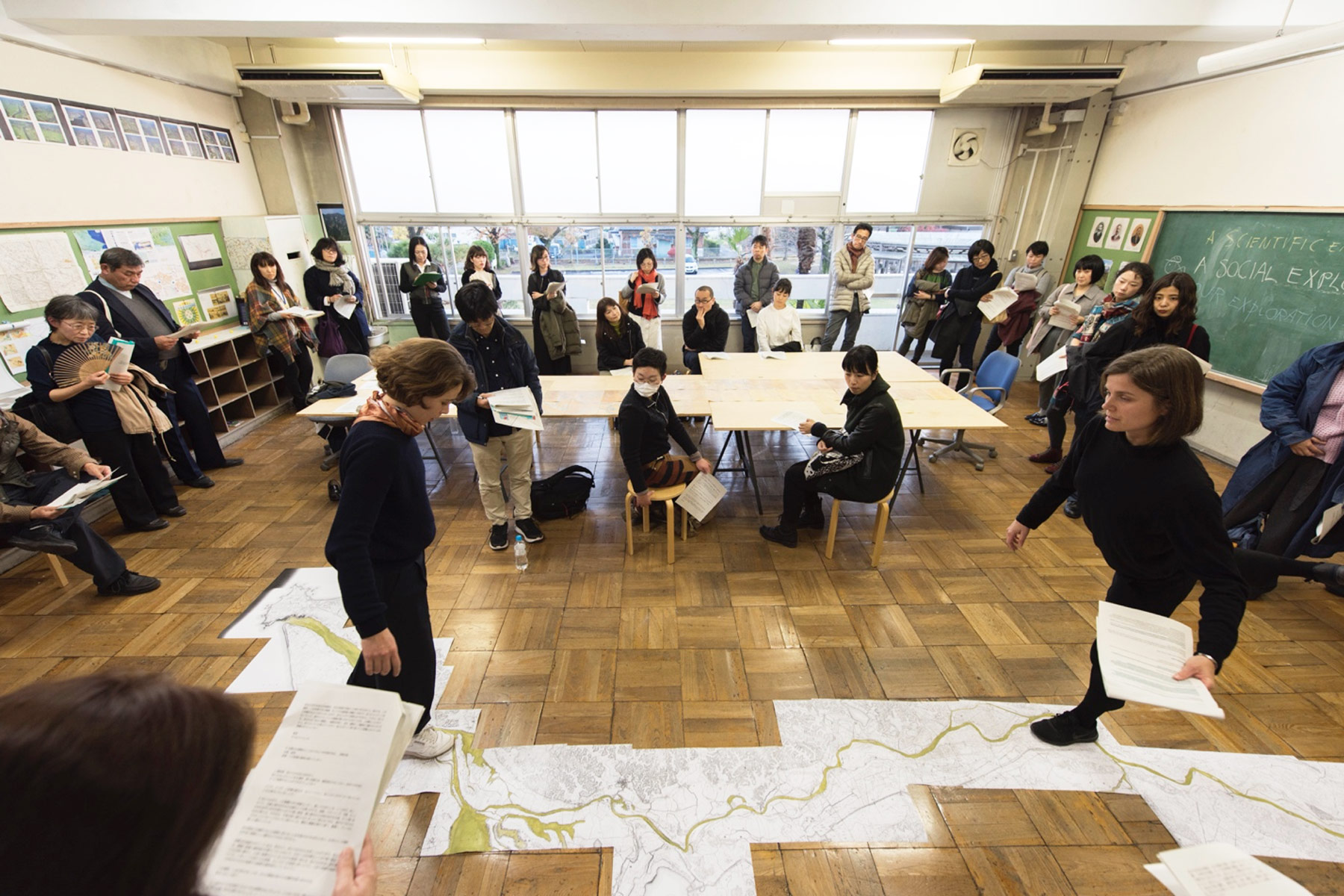
Artist-in-Residence Program

Artist-in-residence program provides opportunities for artists in the field of contemporary art to cultivate their artistic creativity and vision since 1994. Located around an hour from Tokyo, a residency at ARCUS Studio allows participants in the program to come into contact with the contemporary art scene in Japan as well as devote themselves to their creative endeavors in a calm environment while interacting with the local community. Through the support the program offers from its dedicated team of coordinators and regular tutorials with a curator, artists are able to search for and explore approaches in their practices and undertake new challenges in their artistic expression.
The program particularly emphasizes research-based practices and presents the initial results of these processes at open studios. It welcomes ideas for artworks and projects that develop out of encounters with people, the land, and culture, and aspire to form critical discourses that are open and international.
- Duration
- Approximately 90 days
- Program Provisions
- A private studio, accommodation, transportation, production fee, living expense, and staff support. (567,000 JPY is provided as a living expense and production fee in 2023. The allowance is subject to change.)
- Open Call
- January through March (TBD)
- More Info
- Past Residents
2024 Resident Artist
ARCUS Project’s Artist-in-Residence Program received applications from 512 applicants from abroad (62 countries and regions) and 22 artists from Japan. Following a careful screening process, Eva Seiler, Hyphen― and Tanji Rie have been selected as the 2024 residents. The artists will participate in a residency at ARCUS Studio in Moriya, Ibaraki, for 90 days from August 30 to November 27, 2024.
As the judges for this year’s applications, we welcomed Goto Oko, a curator at Contemporary Art Center, Art Tower Mito and Jihye Yun, a curator at The National Art Center, Tokyo who made the selection through a process of discussion with the ARCUS Project Administration Committee.
Overview of the 2024 Selection
An overview of the applications shows that a relatively high proportion were inspired by cultural anthropological perspectives and discussions, especially those from North America and Europe. During the selection process, we were particularly impressed by highly ambitious attempts to bring light on the modern societies which have spread throughout the world and the depth of their history, such as those which question the relationship between Japan and Europe through non-native plant-life, those dealing with human perceptions of animals, plants and landscapes as constructed through animation and trade, and those which made comparisons of cultures through the keywords of labor and earthquakes. The selection was therefore difficult, yet eventually, we chose from outside of Japan an artist who strives to discover the potential for transformation of modern society through metamorphosing insects, and a collective which unravels their own country’s history through the relationship of prominent artists from their country and Japan. And from the domestic applications, an artist who creates works based on the fact of a park within Ibaraki Prefecture having been the site of military exercises was selected. These three groups will be spending 90 days in residency from late August through until late November.
Ozawa Keisuke (Director)
2024 Resident Artist
Eva Seiler
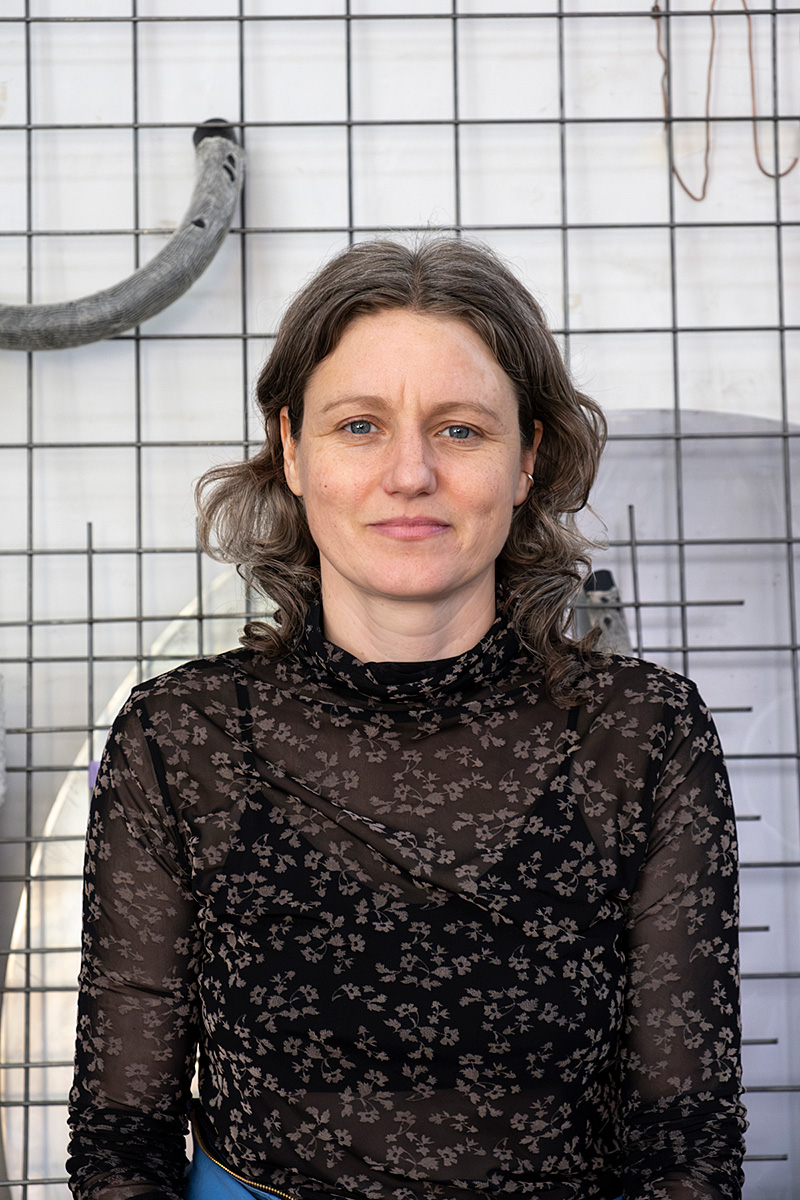
Born in 1979 in Germany, and based in Vienna, Austria. Through objects created from organic materials and manufactured goods, Seiler’s works interrogate the relationship between humans and animals. They recontextualize the socio-culturally constructed relationship between the two, while actually being used on both. Based on literature and field research, her works are not material documents which trace theoretical or academic discourses, but rather, are representations of the organic and active relationship between humans and the actors they engage with. Seiler’s strong figurative technique and understanding of space gained through studying sculpture, combined with her curiosity of new relationships of humans through research, come together in her creative work to illuminate the potential of the post-modern age. Past exhibitions and activities include Tuesdays@Secession, with Johanna Tinzl (Secession, Vienna, 2022), BMKOES scholarship (2022), and collection for the Wien Museum.
https://www.evaseiler.com
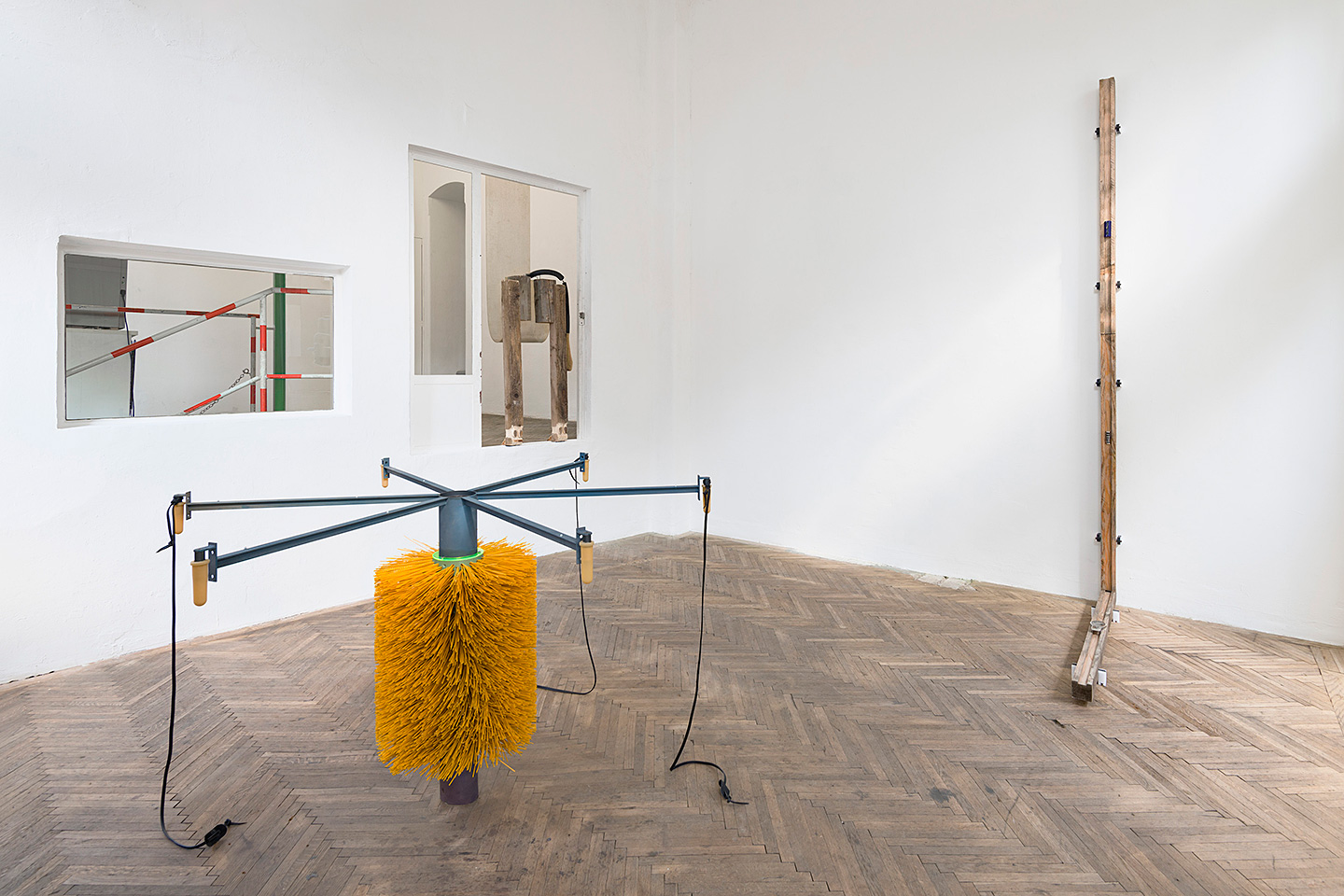
Yvonne
Installation, 2020
Photo: Georg Petermichl
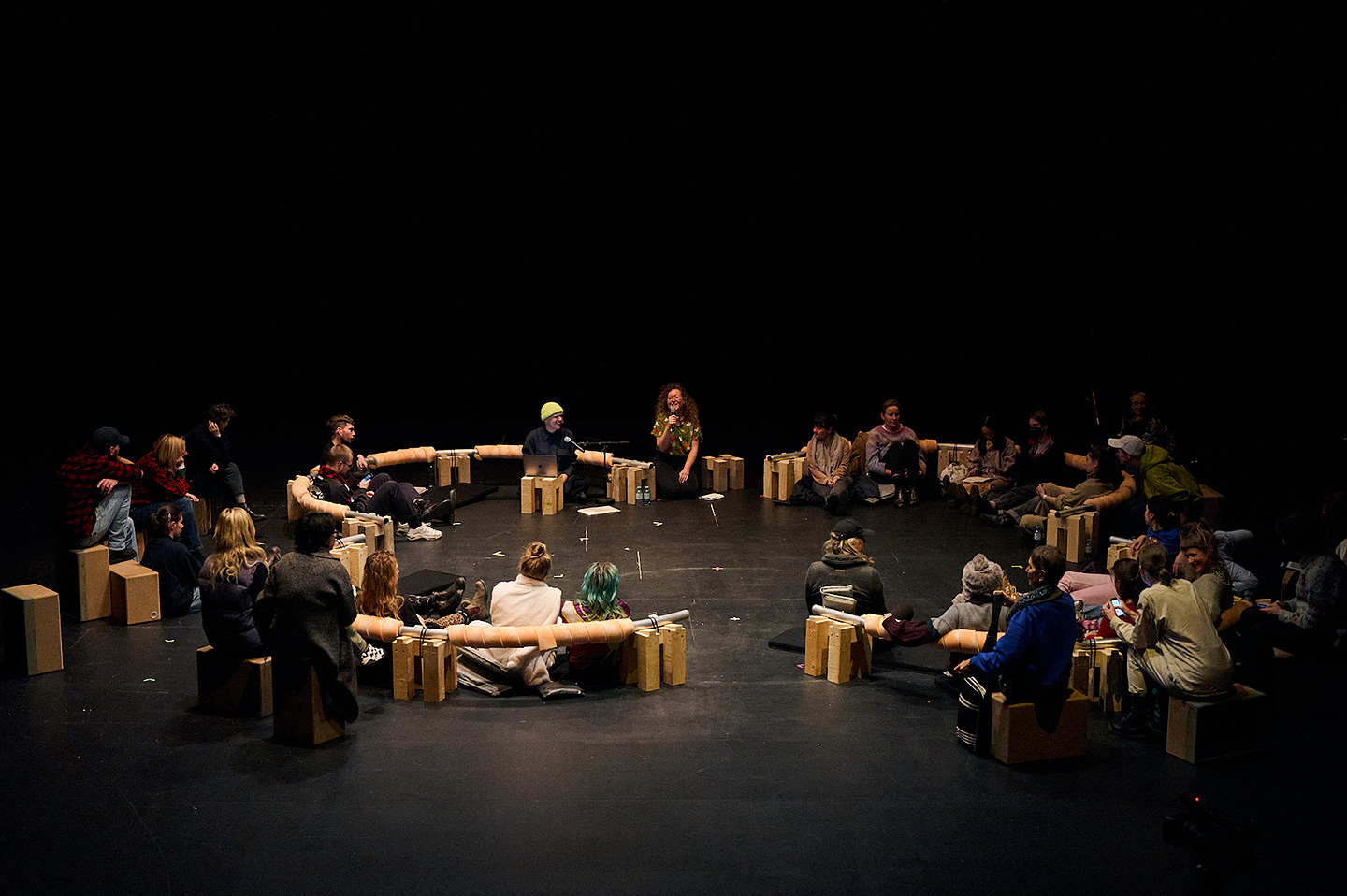
Together the Parts (Seat Object)
Installation, 2022
Photo: Markus Gradwohl
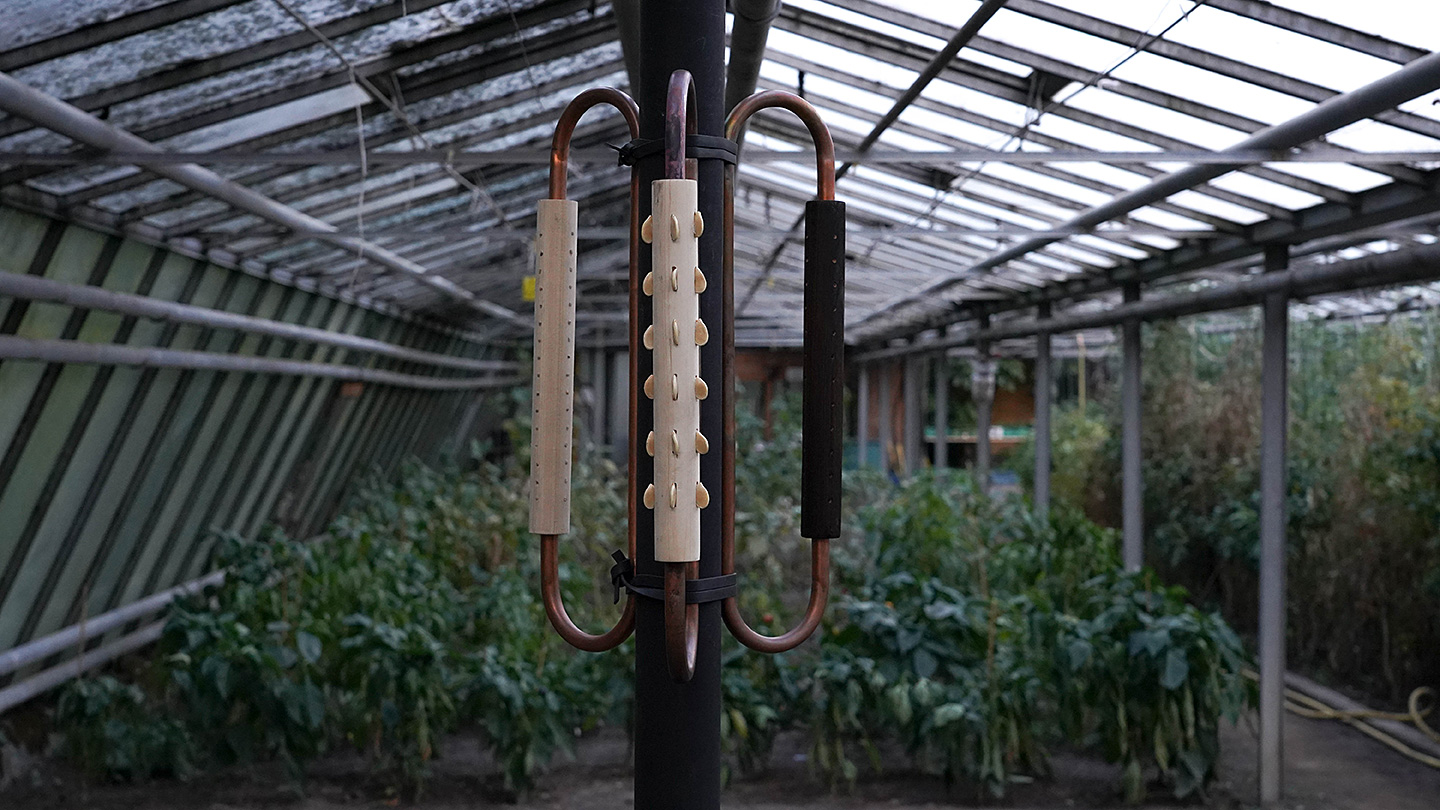
The Keeper of the Seeds
Copper, rubber, steel, wood, seeds, 2021
Photo: Viktoria Bayer
Process
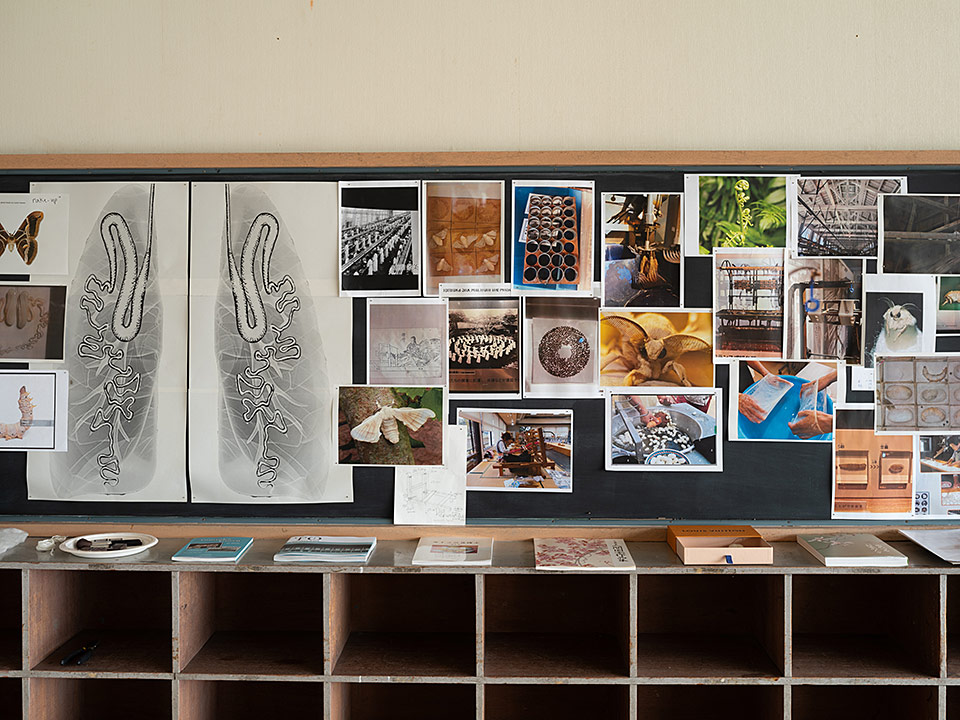
Research materials
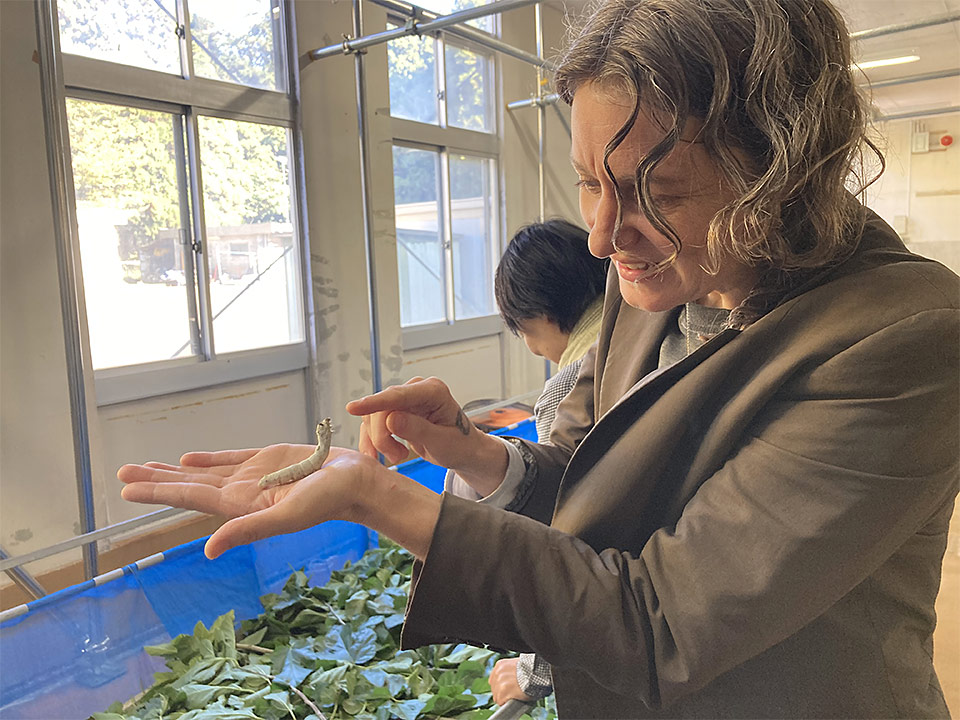
Visit to the Institute of sericulture and silk science,
the Dainippon Silk Foundation
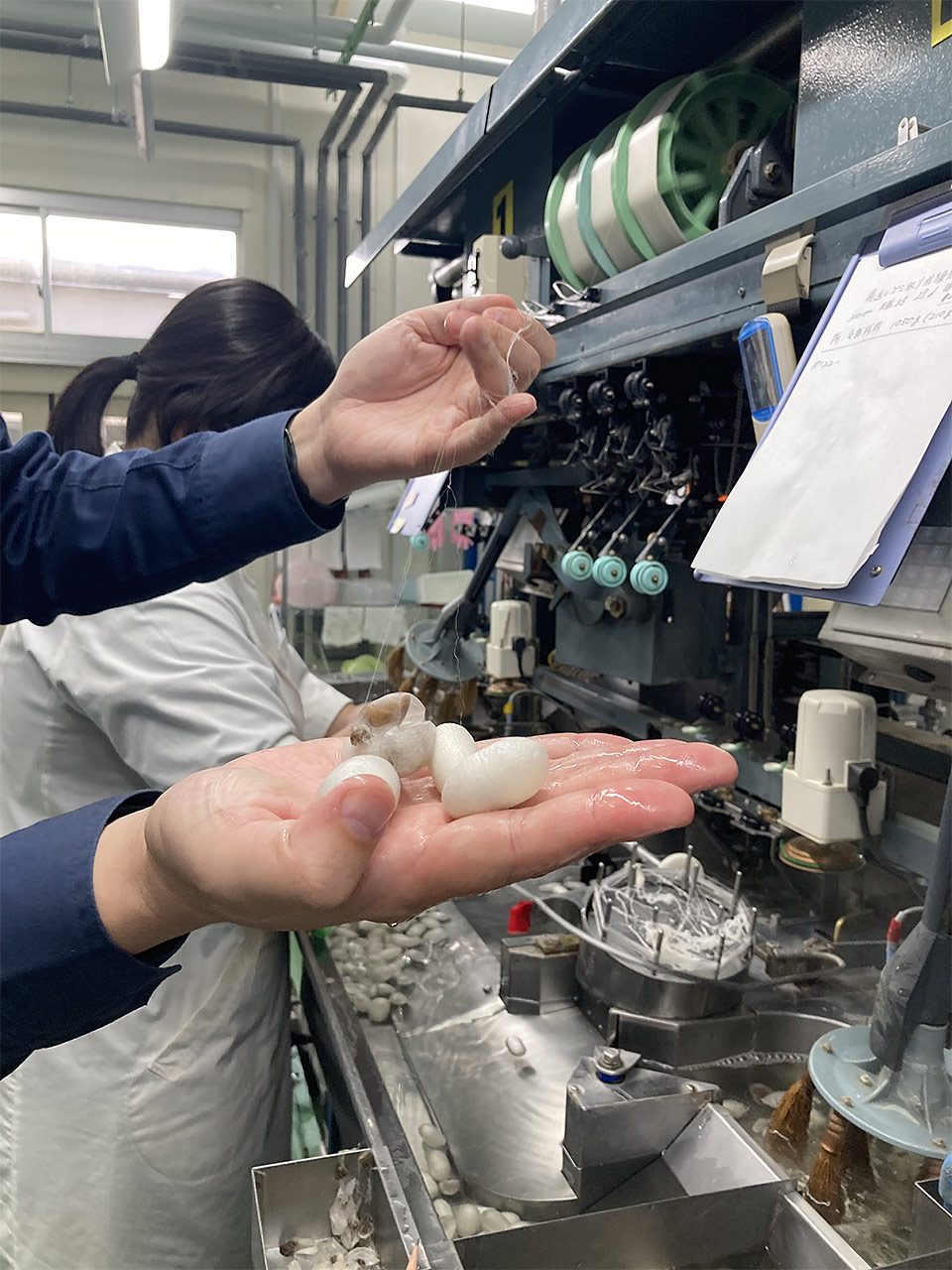
Visit to the Institute of sericulture and silk science,
the Dainippon Silk Foundation

Visit to the Yuki tsumugi workshop
Open Studio

East Cocoon Warehouse
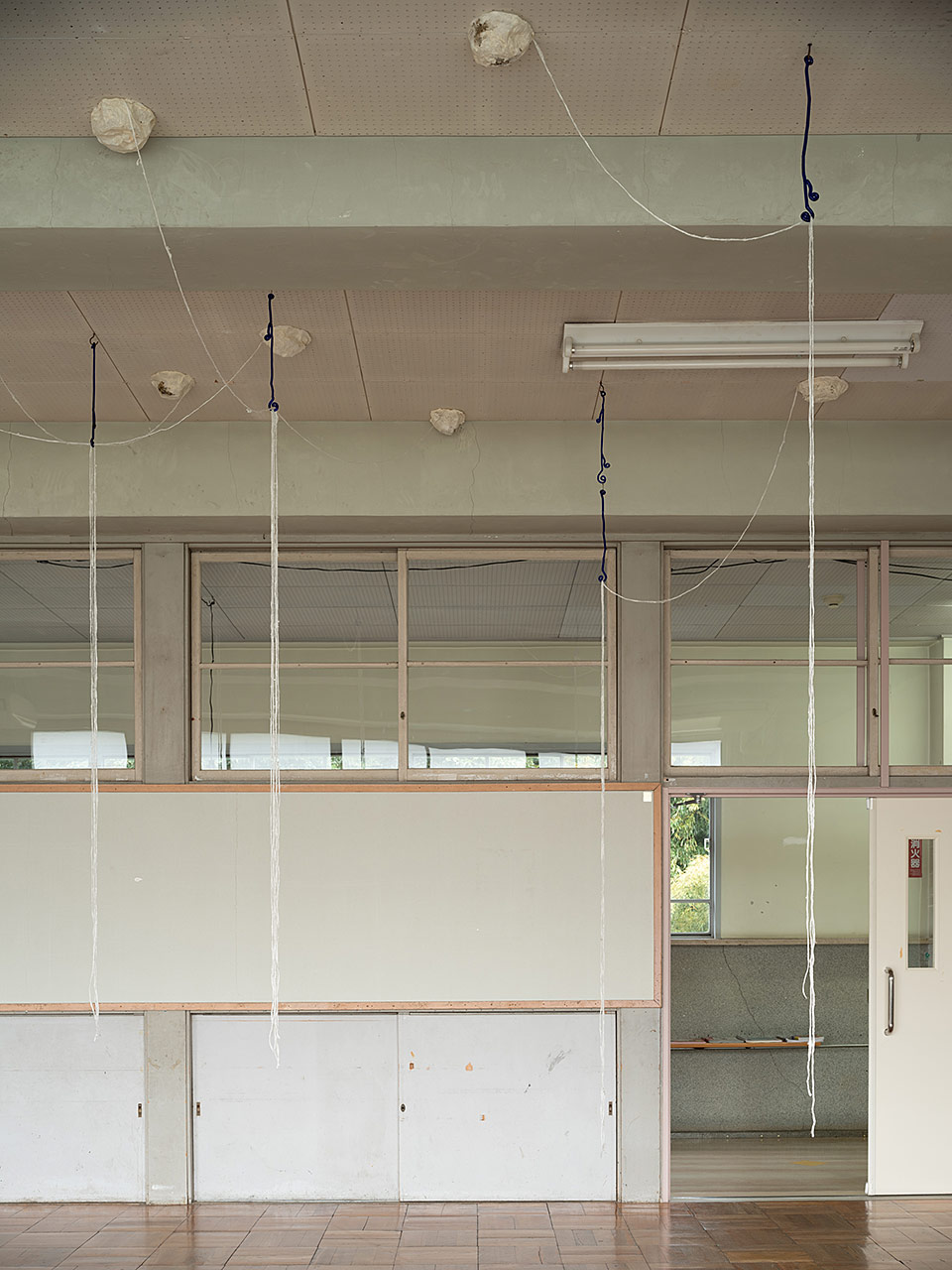

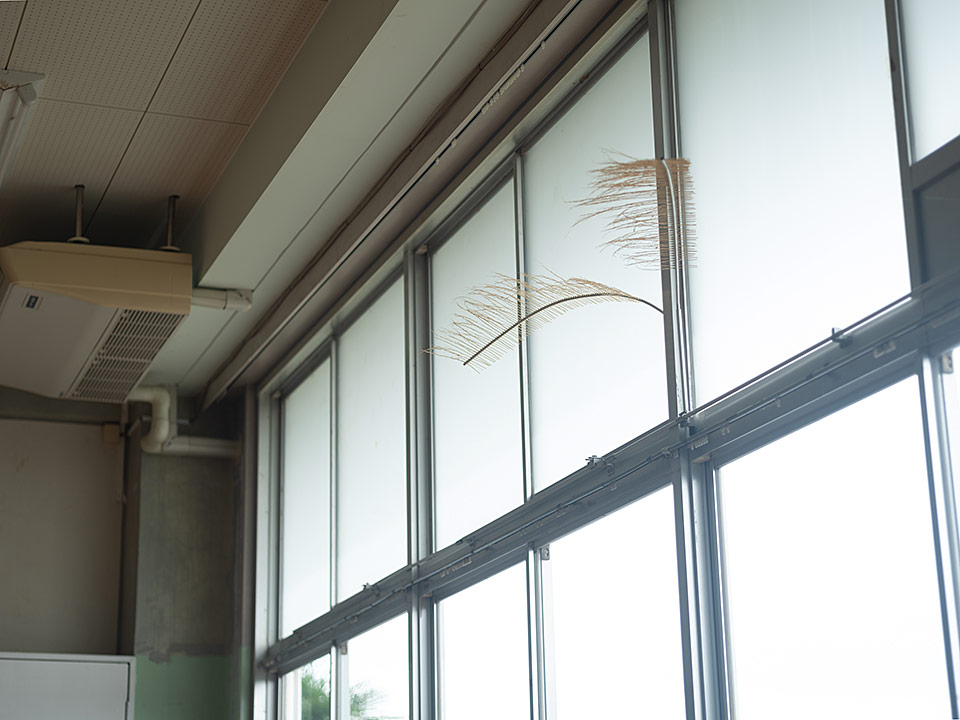
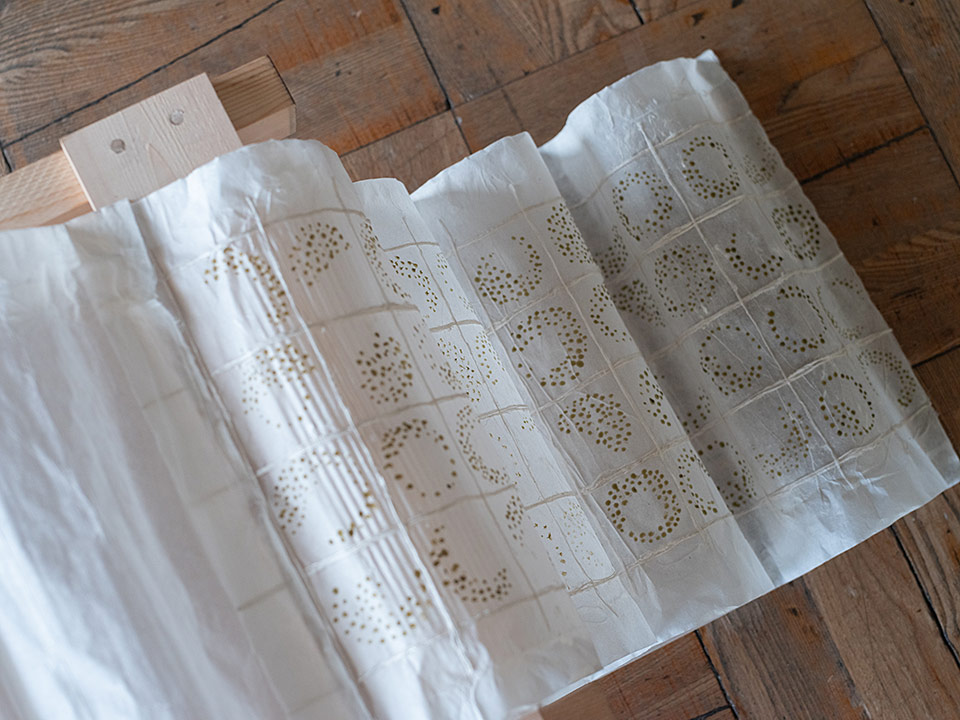
Artist Statement
East Cocoon Warehouse
My project explores the symbiotic entanglement between the mulberry tree, the silkworm, the female spinner, and the tools used in silk fabrication. At ARCUS, I engaged in on-site visits to both traditional and contemporary silk-production facilities and encountered humans and silkworms in sericulture. I explored how both bodies contribute their expertise while being shaped by the industrialization of the silk-making process.
The morphology of silkworms was remodeled by breeding practices, just as human bodies were affected by machinery, humid environments―which harmed the spinners’ lungs―and long working hours, all in pursuit of higher production. Young female mill workers and the silkworms together formed the (invertebrate) backbone of Japan’s industrialization.
I am drawn to the contrast between the unstained delicacy of the final silk product and the steamy, oily production environments.
A crucial aspect for me is how we utilize the transformative power of the silkworm by wearing garments made from its shimmering protein filament to alter our appearance. This raises questions about what we might learn from the silkworm’s shapeshifting abilities―its capacity to break and transform previously established rules, “unraveling new shapes and forms that influence how we relate to the world around us.”*
All these impressions and encounters have deeply informed my artistic approach. I have gathered materials and instruments used in silk production and repurposed them in ways that diverge from their original application.
* Atkinson, Elizabeth Eleanor Jacqueline. (2019. March 1). Unravelling the secretions of the silkworm. JAWS: Journal of Arts Writing by Students, Volume 5, Issue 1. https://intellectdiscover.com/content/journals/10.1386/jaws.5.1.93_11
Reason for Selection
With inspiration from insects in traditional Japanese culture such as their depiction in ukiyo-e prints, urushi lacquerware and metalwork, Seiler’s planned works will represent modern society through the relationship between silkworms and humans. Silkworms, the larvae of moths, cannot live without human beings; and it is through silkworms that humans can obtain silk. Unravelling this mutual interdependence, she attempts a rereading of relationships such as servitude and labor, care and exploitation. Paying attention also to the capacity of the silkworm to change its own form, she sees therein the potential to break through the fixed relationship between humans and insects, and imagines a future which could be created if both could be interrelated as active subjects. During her residency with the ARCUS Project, Seiler will visit sites of Yuki tsumugi (high-grade silk textile fashioned by hand in a folk art style) in Ibaraki Prefecture, the Tomioka Silk Mill in Gunma Prefecture, and silkworm farms; conducting field work on the site of silk production and also observing the silkworms’ ecology. At the same time, she will also research the equipment and architecture used in silk farming. Seiler was selected for the high evaluation of how she connects abstract academic theories and discourse with concrete events actually taking place, her ambition to design a future in which humans and insects mutually assist one another, as well as her figurative ability to express this in her work.
Comment for Open Studio
In her residency, Eva Seiler explored through sericulture the kind of framework of the times modernization was for both humans and non-human beings. Two factors led her to do so. One, was that Seiler herself has until now through her sculptural works dealt with the relationship between humans and animals. The other was her visit to Japan last year, when she learned of the closeness of insects to Japanese culture after seeing an exhibition on the theme of insects. And from here, she developed an interest in the life and culture formed by humans and insects.
Once her residency began, Seiler visited the Tomioka Silk Mill and a silkworm farm in Tokyo, as well as experienced production of Yuki tsumugi silk in Ibaraki Prefecture. She hereby began to research how female mill workers and silkworms worked together to support modernization, and the machinery with and environment in which they did so. She then expressed this from three angles. The first was positioning glass objects like bracken, inspired by the shape of parts of the thread-spinning machines. The second was taking fiber from the mulberry tree, the same species that silkworms eat, and making this into a kimono, into which the silkworm’s internal organ which is used for creating thread is stitched as a design. It is also impossible to miss the fact that this is displayed on a structure resembling a loom. And finally, in a laboratory-like installation reminiscent of the science that supported modernization, she makes reference to the labor through which silkworms create cocoons. Through her practice, Seiler came to consider the overlap between women’s labor in factories, and silkworms working for the sake of humans. The works which emerged from this relationship evoke a sense that both beings trapped by labor were dreaming outside of the modernity that produced them.
(Director, Ozawa Keisuke)
2024 Resident Artist
Hyphen―
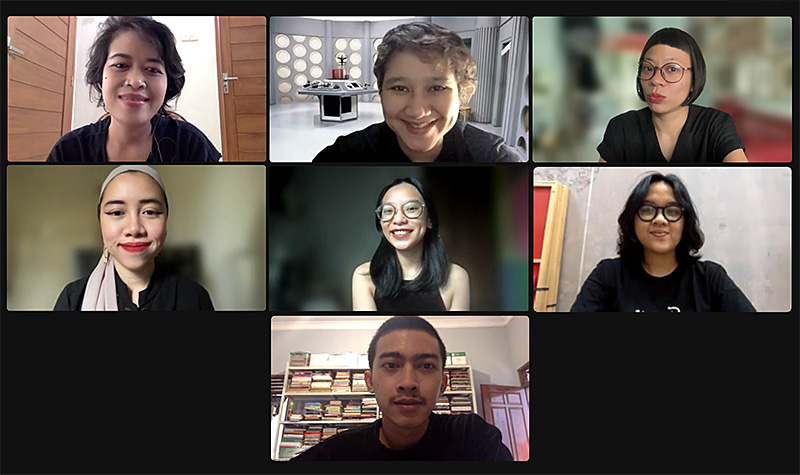
A seven-member research group co-initiated in 2011, working from Yogyakarta, Indonesia. Their research-focused artistic activities take various forms such as publishing, exhibition-making, archiving, open-ended conversations, karaoke, barbecue nights and feasts. Selecting a particular person and unravelling Indonesia’s history and identity through the achievements of that individual, the group strives to capture the complexities of the nation state. Among their previous works is the film Visualization of the National History: From, by and for whom?, which features dioramas made under the supervision of the eminent sculptor Edhi Sunarso to take another look at Indonesia’s national history. This depicts the contradictions in the construction of a unified identity of the Indonesian nation due to colonial influences, geographical conditions as a group of islands, state violence and vengeance, as well as its diverse languages. Past exhibitions and activities include As if there is no sun (curation) in the 58th Carnegie International (Pittsburgh, USA, 2022-2023), Jakarta International Literature Festival (As Danarto dkk, Taman Ismail Marzuki, Indonesia, 2022), and Danarto dkk (participation in the Buzdokuz Magazine’s project in the 17th Istanbul Biennial, Turkey, 2022).
https://hyphen.web.id
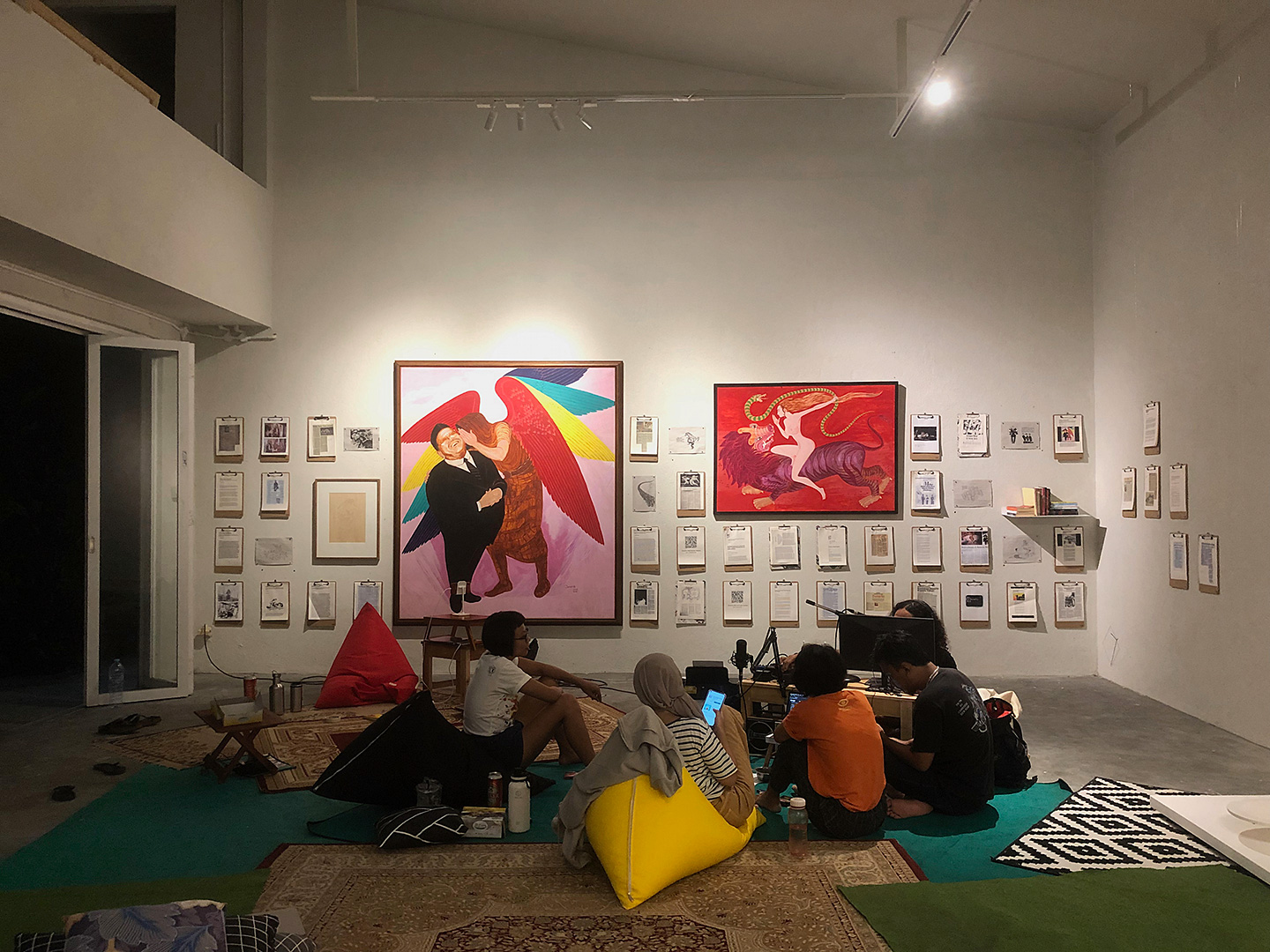
Taman Bacaan Danarto at Jendela Institute (Yogyakarta)
Project, 2022
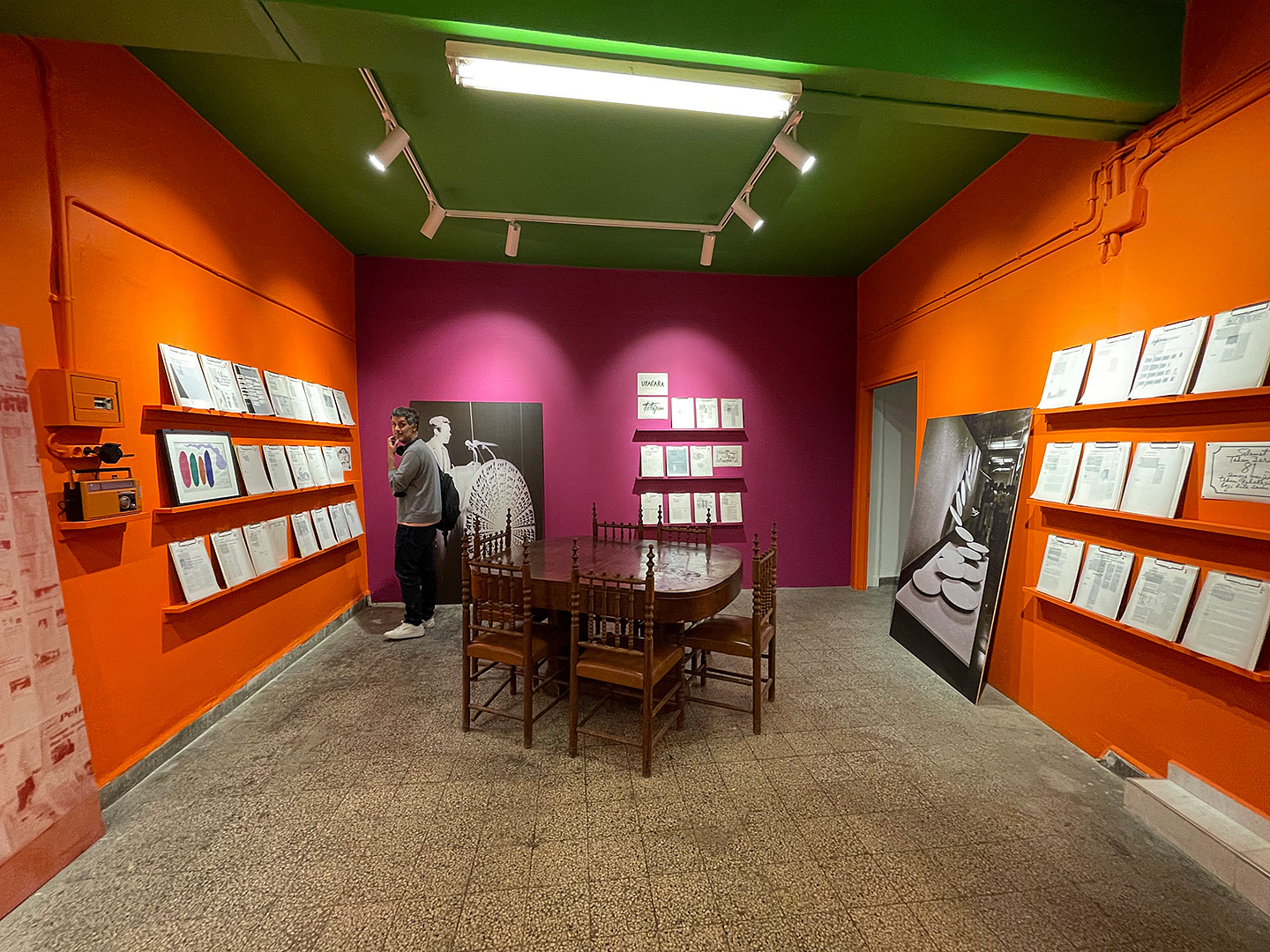
Taman Bacaan Danarto at Jendela Institute at 17th Istanbul Biennial in Barin Han (Istanbul)
Project, 2022

Loka-loka: Habis tak sudah (Over yet undone)
Workshop, 2022
Process
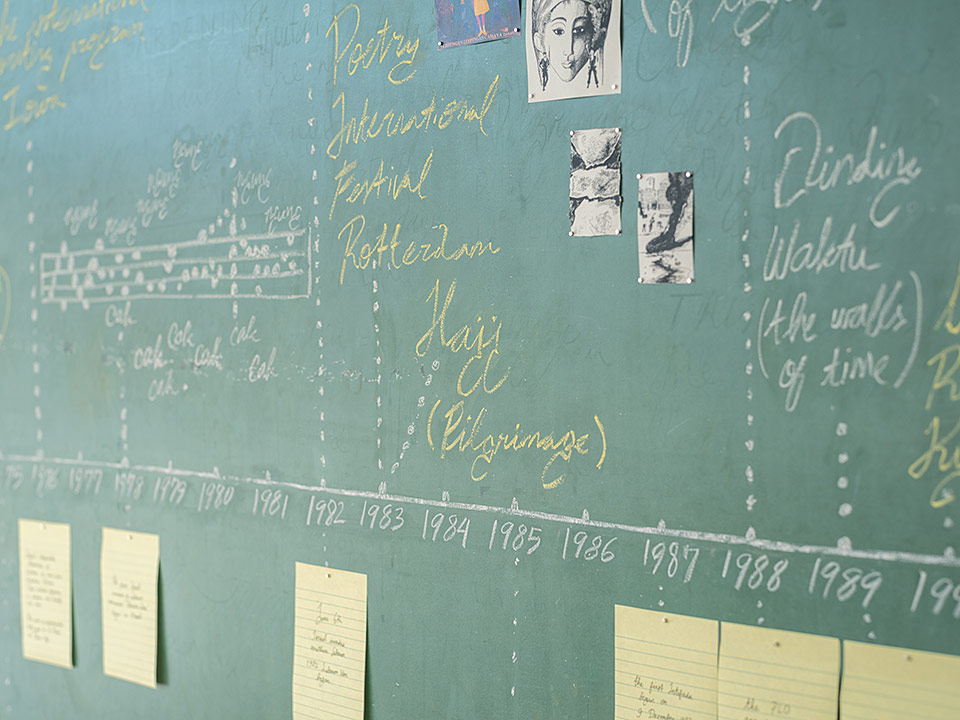
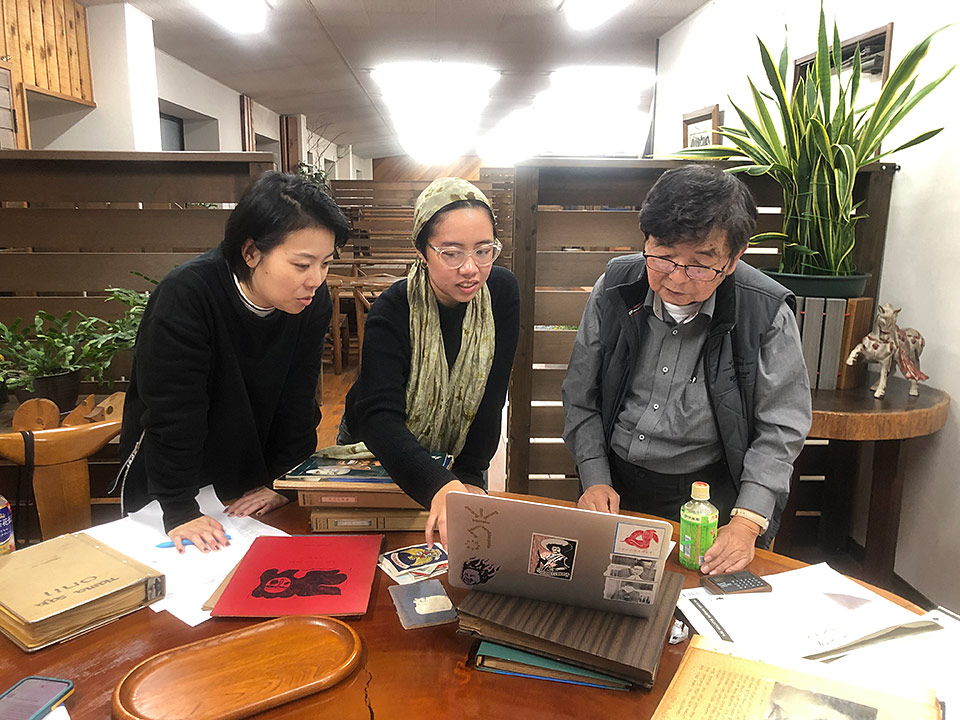
Meeting with Nakagawa Katsuhiro, a member of staff
at the Osaka Expo in 1970

Visit to the Center for Southeast Asian Studies, Kyoto University
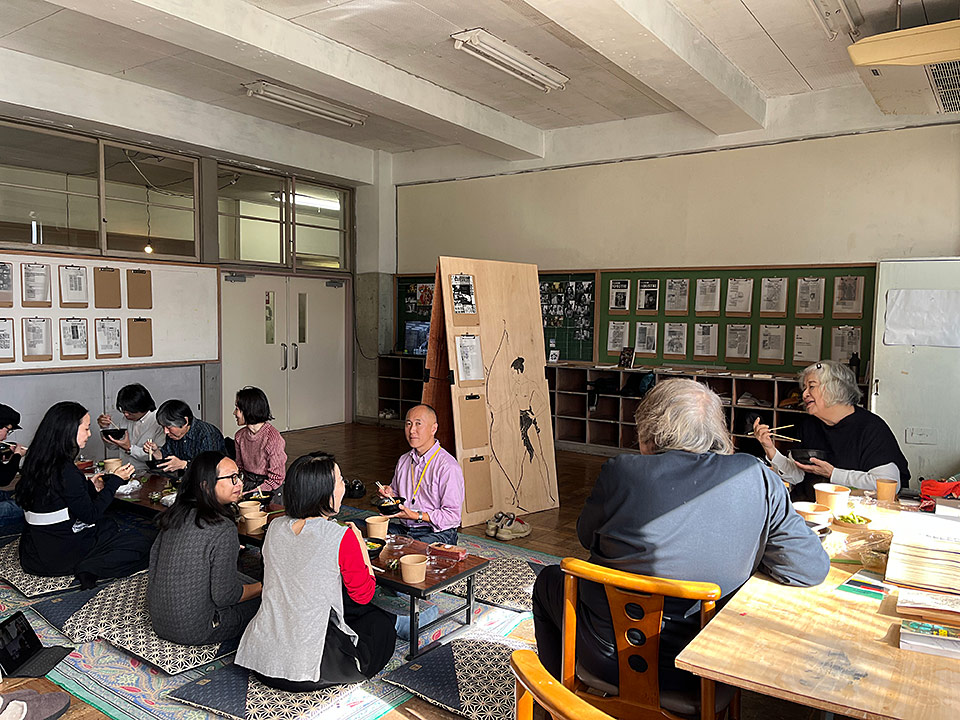
Lunch gathering with JAALA (Japan Asia Africa Latin-American
Artist Association) members
Open Studio
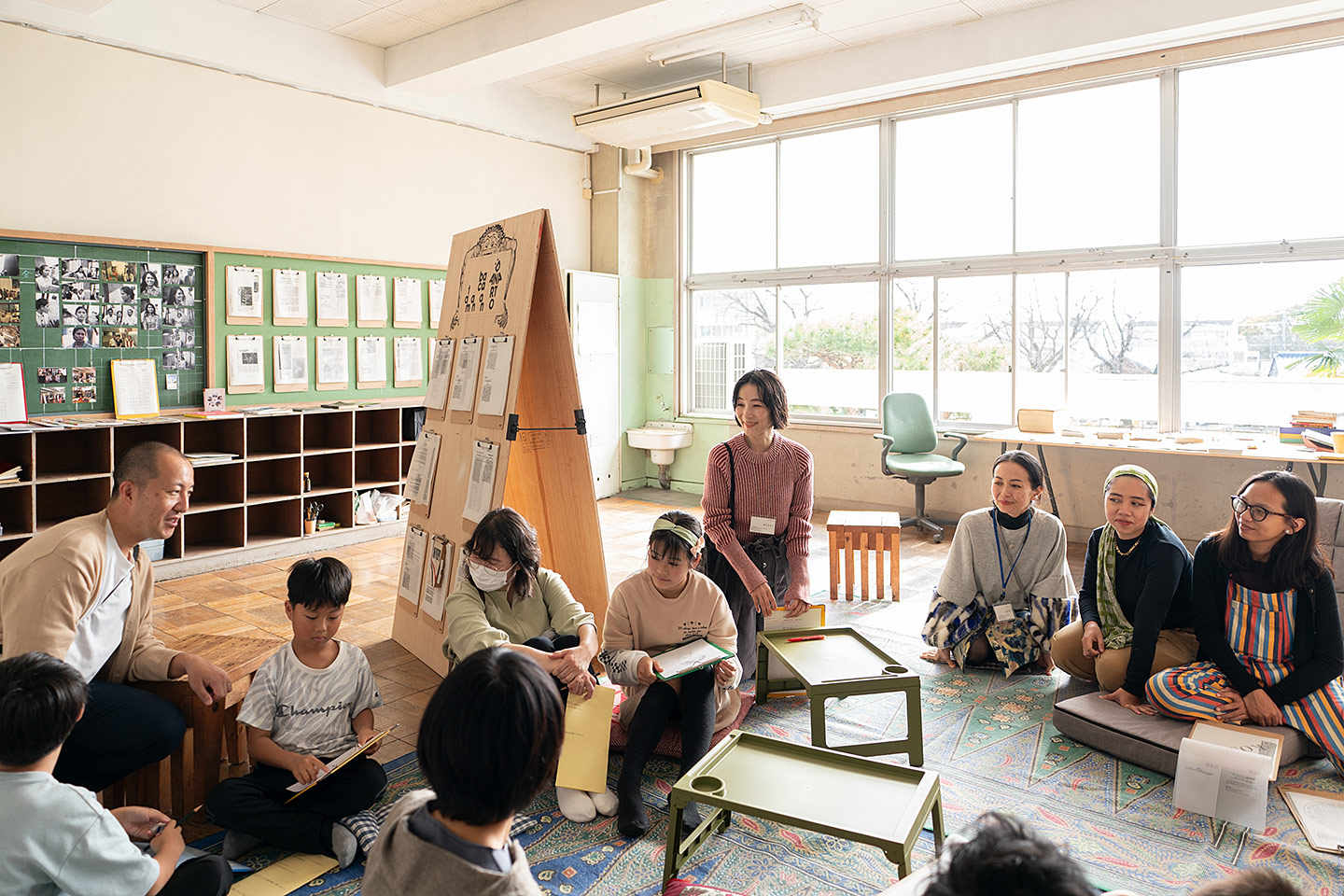
Taman Bacaan Danarto [Danarto Reading Park] by Hyphen― with Danarto dkk [Danarto and friends]
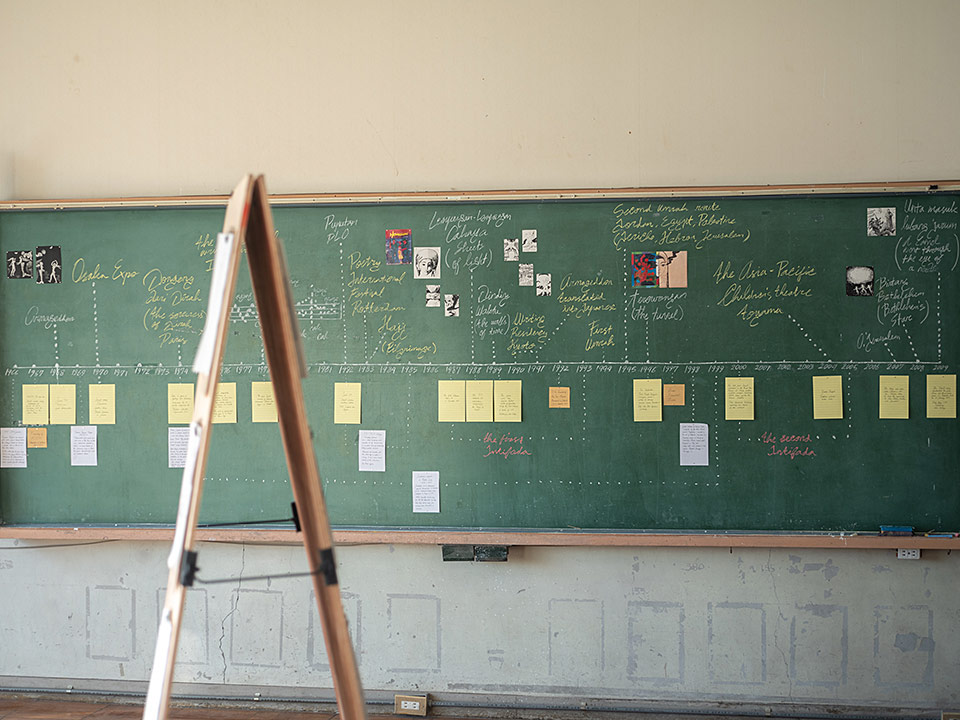


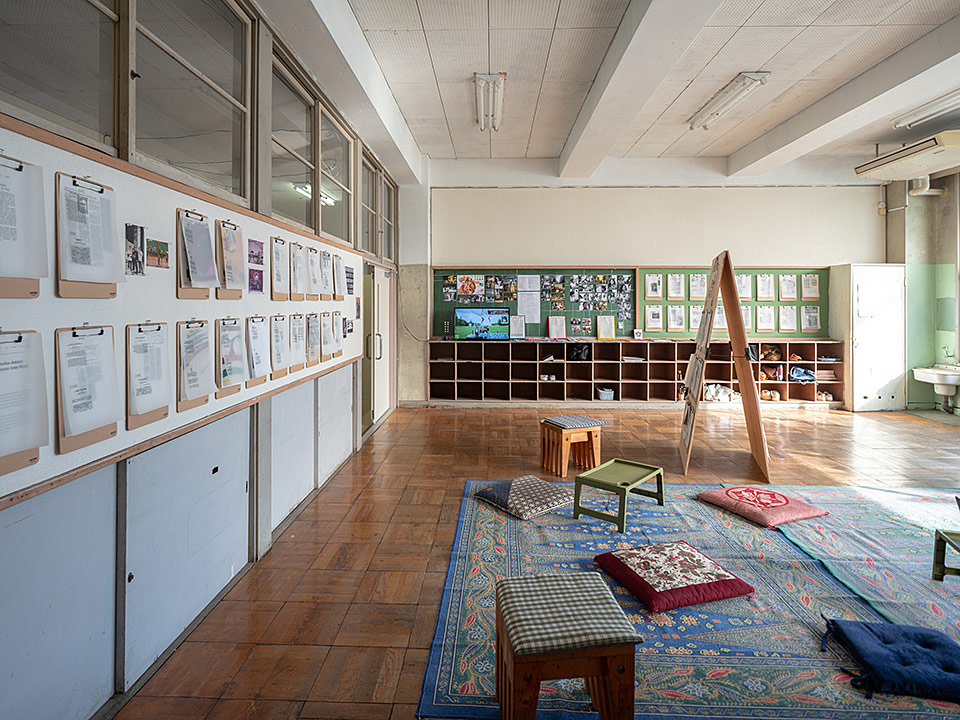
Artist Statement
Taman Bacaan Danarto [Danarto Reading Park]
by Hyphen― with Danarto dkk [Danarto and friends]
Knowing that ARCUS is located inside a former school, our minds have been set to our open library format―“Taman Bacaan Danarto” [Danarto Reading Park]. For many, libraries evoke memories of skipping class, chewing gum behind the bookshelves, and whispering―that often sparks the loudest laughter. That’s the reading park we envisioned. Instead of approaching visitors as viewers, we want to treat them as people coming into libraries as they automatically become an active agent who comes to read, to advance their knowledge―therefore themselves―, to be a part of the library set up. Therefore, we also reached out to our friends to join our research process–not only during this residency, but also what could come after. As of now, we are joined by David Teh, Kumakura Haruko, Nakamura Yuta, and Osaka Koichiro.
Danarto’s (1941-2018) past engagement in Japan as our departing point has led us to a series of encounters with individuals and groups that contribute to growing the Taman Bacaan together. From Nakagawa Katsuhiro-san, who worked for the Osaka Expo 1970 and made lasting friendships with people from Indonesia Pavilion (where Danarto was the stage designer); researchers of Center for Southeast Asian Studies in Kyoto University (where Danarto did a residency in 1990-1991) and JAALA (Japan, Asian, African, Latin-American Artist Association), in relation to our publication of a selection of Danarto’s short stories from 1968-2009 that are about and around Palestine. Taman Bacaan Danarto at ARCUS is not only a space for sharing our ongoing research, but also a hub to find comrades and solidaric people within the arts community in Japan.
Reason for Selection
Their ARCUS Project residency work will shed light on the Indonesian artist and playwright Danarto (1941-2018). Taking the stage art created by Danarto for the Indonesian Pavilion at the 1970 Japan World Expo, as a point of departure, their project will trace two works related to Japan. One is Danarto’s only novel Asmaraloka, which was written between 1990-1991 in Kyoto. The second is Bumi di Tangan Anak-Anak (Earth in the Hands of Children), his script awarded best work at the Asia Pacific Festival of Children’s Theatre held in Toyama Prefecture in 2004. The task of unravelling and reconnecting Indonesian history and Danarto’s experiences in Japan will be opened to other artists and collectives through an open studio, and developed further. Highly evaluating their project’s rethinking of the nation state through a transnational perspective without aiming for completion, Hyphen― was selected for this residency.
Comment for Open Studio
Hyphen― is a 7-member research group co-initiated in 2011 and working from Yogyakarta. Through researching and archiving materials on figures significant in Indonesian culture, they reconsider the path that Indonesia has taken in relation to other polities and cultures.
During their ARCUS residency, they worked to create an archive of the writer and playwright Danarto (1941-2018), who had engaged with Japan on three occasions. The first was his participation in the Indonesian Pavilion at the 1970 Japan World Exposition. Then, from 1990 until the following year he came to Japan on a fellowship from the Japan Foundation, participating in a residence program at the Center for Southeast Asian Studies, Kyoto University. And in 2004, he wrote the script for a work performed at the Asia-Pacific Festival of Children’s Theater in Toyama Prefecture. Creating archives while tracing his footsteps was also a process of learning that which cannot be reached. Nonetheless, almost as if pulling on a fine, breakable thread, Hyphen― sought out and interviewed people who may have met Danarto, or who had been involved in the international exchange programs in which he took part. In the studio, a chronology of Danarto’s activities is drawn on the blackboard; in addition to displays of photographs of the Indonesia Pavilion at the Japan World Expo, a progressive library collecting his writings and materials related to his activities has also been created. The archive will change through changes in the location, composition, and communication with involved persons, continuing to be alive. We hope that you will experience this methodology which imagines history from the small stories which exist before the great history carved out by the state.
(Director, Ozawa Keisuke)
Supported by the Ministry of Education, Culture, Research and Technology Republic of Indonesia

2024 Resident Artist
Tanji Rie
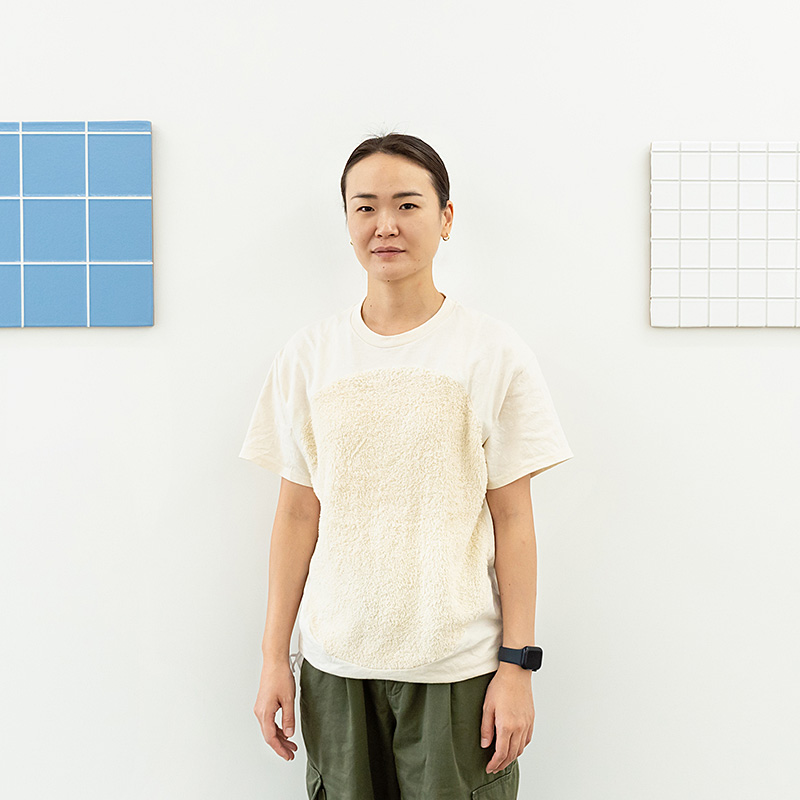
Born in Fukushima Prefecture in 1983, and living in Okinawa Prefecture. Drawing attention to the similar circumstances in social structure of Fukushima where she was born and raised, and Okinawa where she now lives, Tanji creates temporary structures to investigate the relationship between humans and things, as well as humans and the environment. Both Fukushima and Okinawa share a history of having their course determined not through the will of the citizens but through political decisions of the state. When power is asserted, sudden shifts in values can take place, rendering what was once useful no longer relevant. Tanji is concerned with the structures deriving from such social dynamics, as well as the personal happenings which are overlooked in the shadows of those structures, creating works that shake people’s senses of things and of places. In Scenery in Memory (2023), she recreated the interior of her family home which was destroyed by natural disaster, through arranging similar items based on remnant photographs, then photographing this to create her artwork. How reminiscent is this of her now gone family home? Her work represents the geopolitics of Japan’s local communities, interrogating the perceptions of the audience. Past exhibitions and activities include REDRAW TRAGEDY (Künstlerforum Bonn, Germany, 2022), commission work for Hotel Anteroom Naha (2020).
https://rie-tanji.com

Scenery in Memory
Installation, 2023
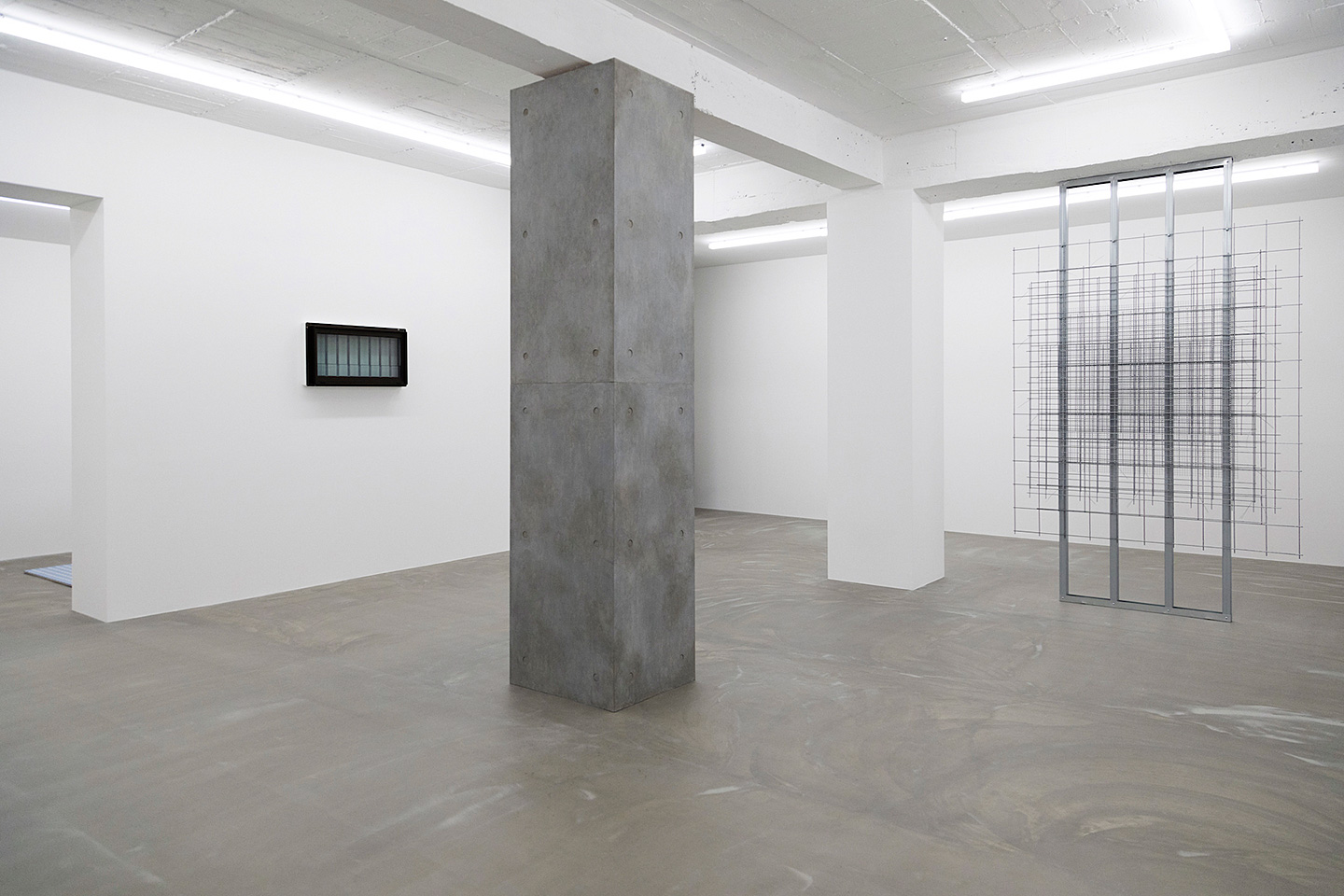
仮説|部分
Installation, 2022

TOHOKU Landscape
Installation, 2022
Process
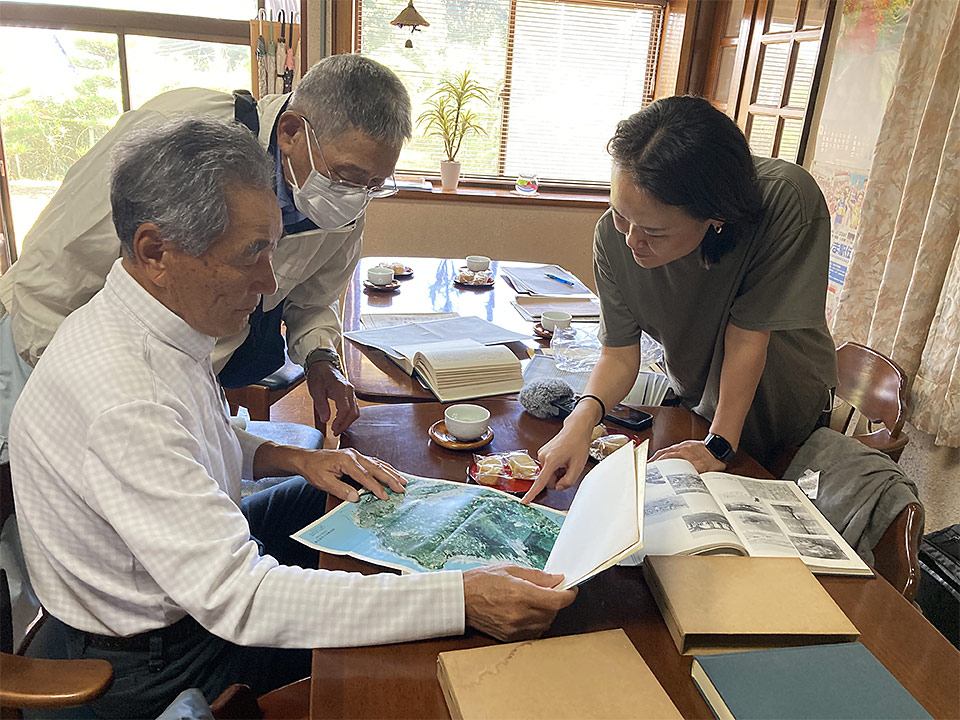
Interviews in Ajigaura (near the Mito Range)
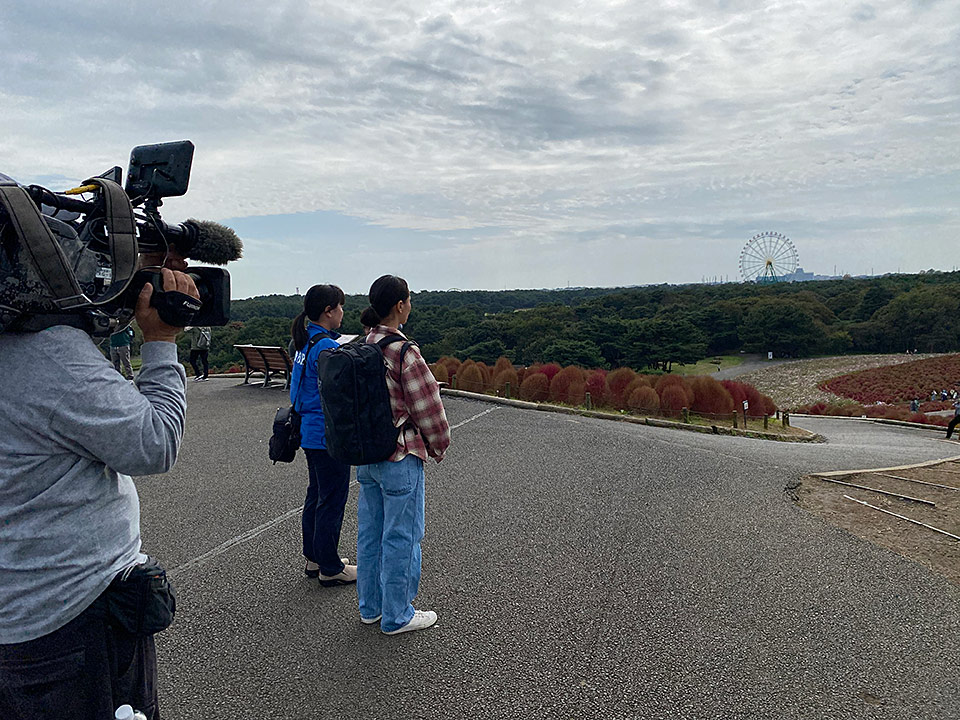
Research at Hitachi Seaside Park


Visit to a sweet potato farmer
Open Studio
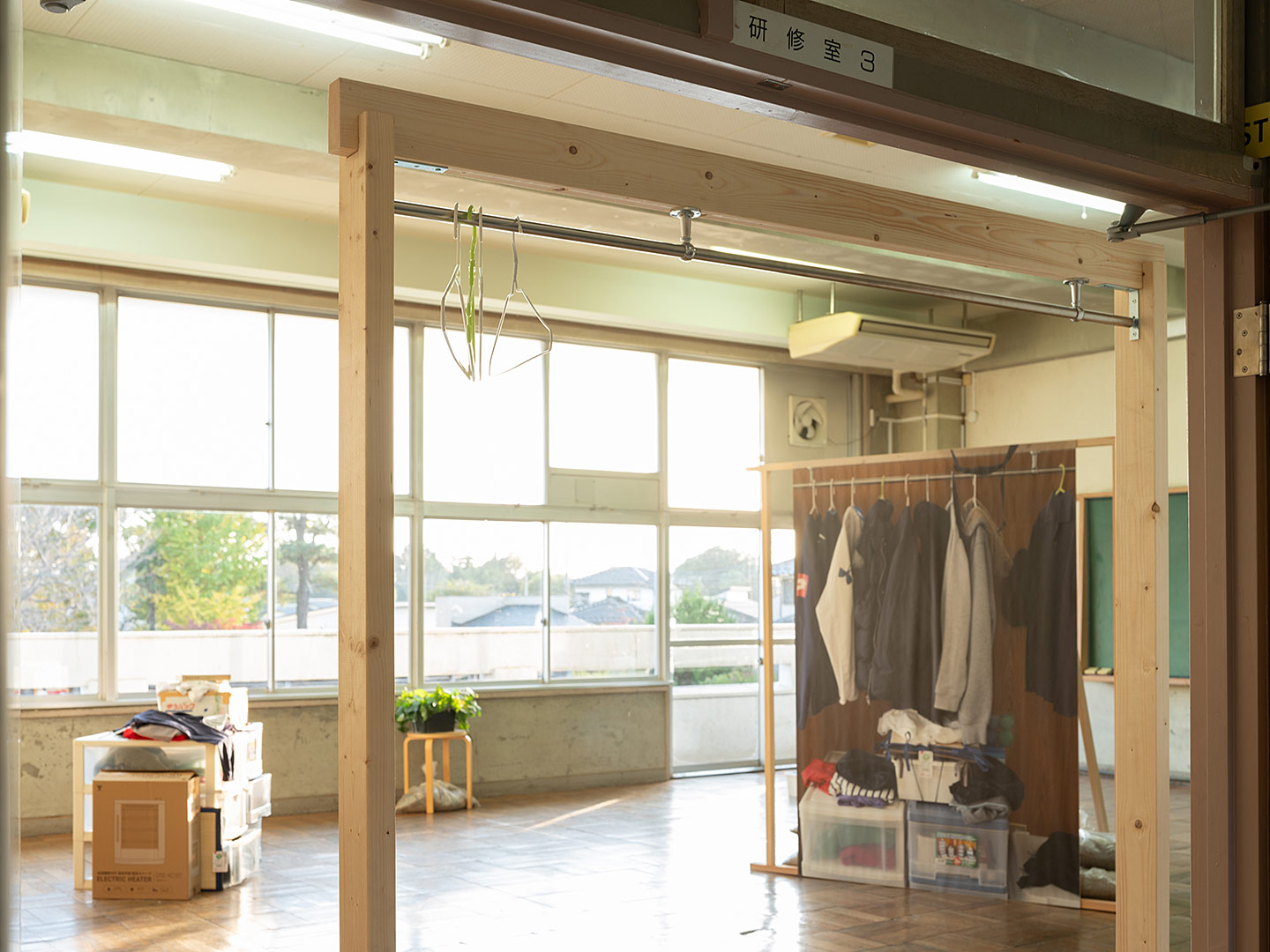
Distantness is f a r and close by
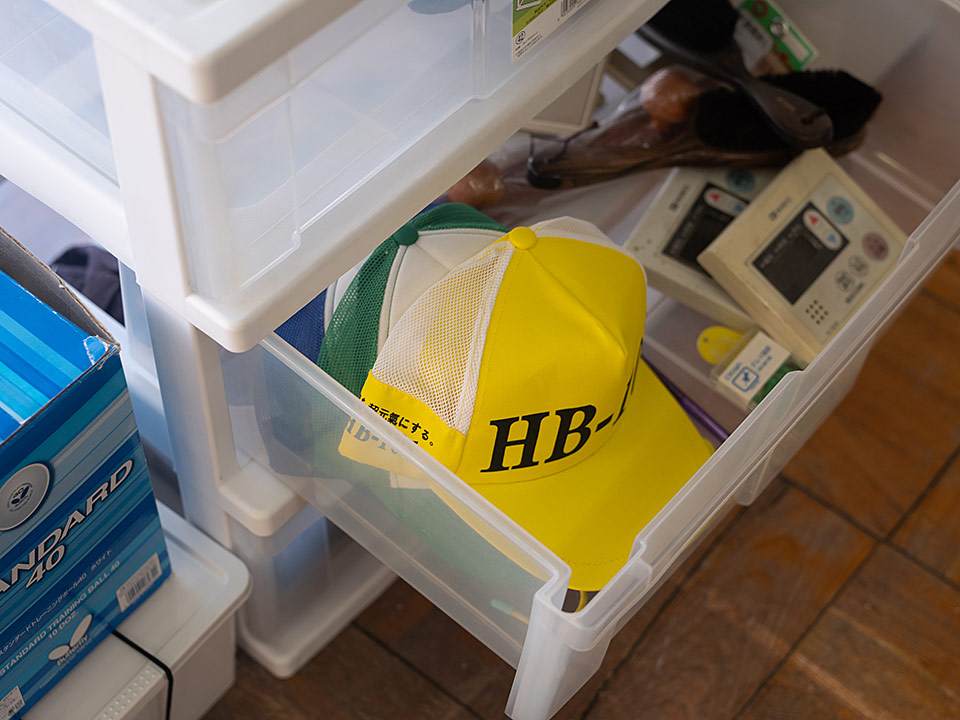
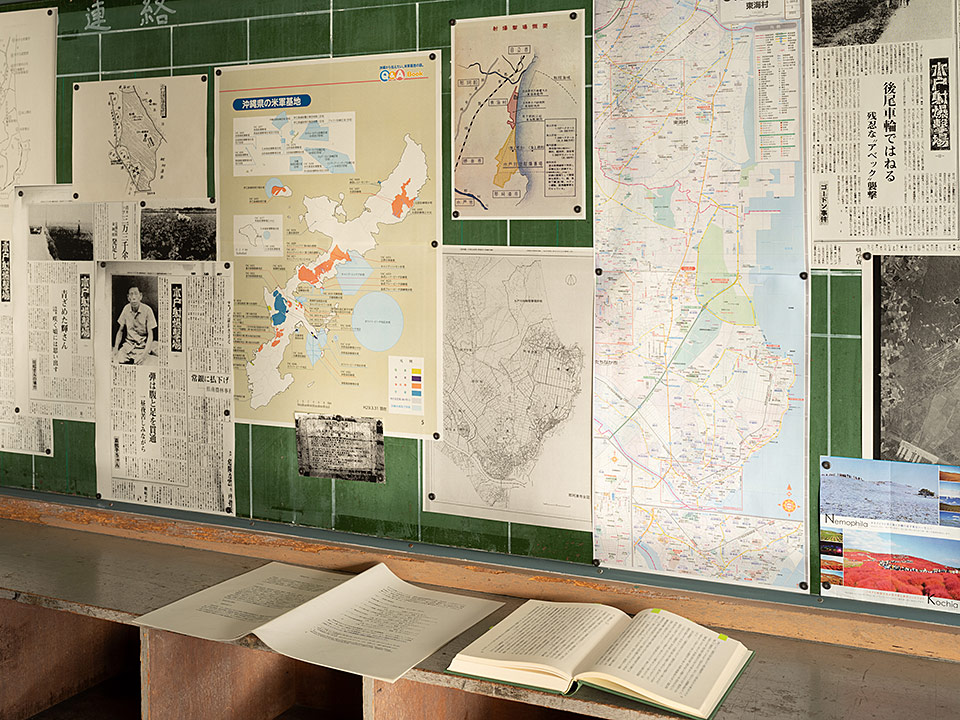
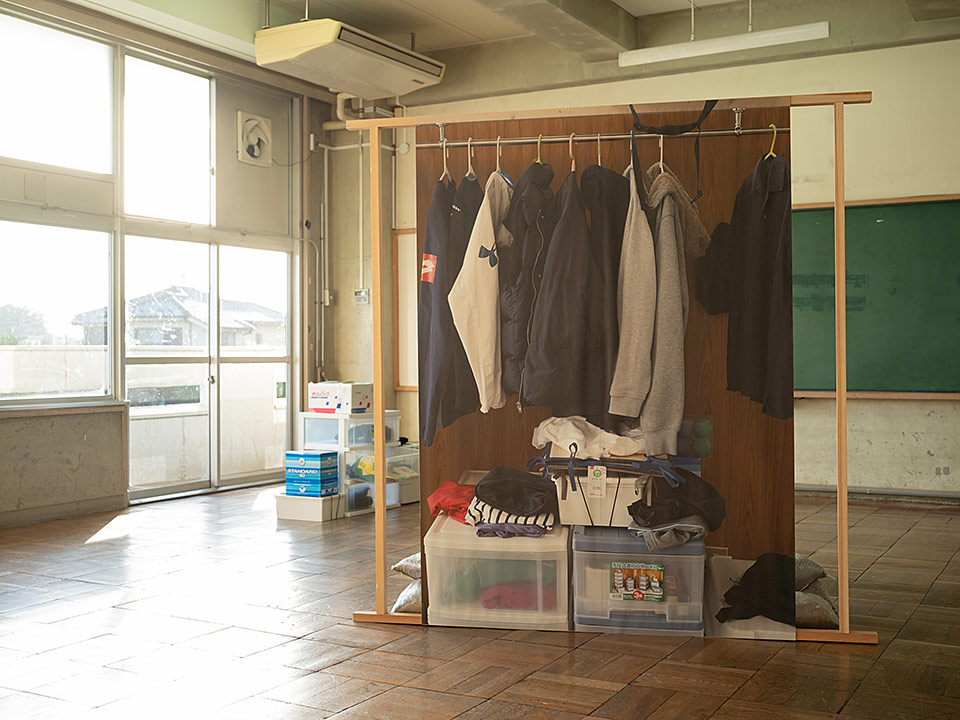

Artist Statement
Distantness is f a r and close by
The area surrounding the state-run Hitachi Seaside Park in Ibaraki Prefecture was once confiscated by the United States military for use as a fighter jet shooting and bombing range. Yet as a result of a more than decade-long movement calling for its reversion, the land was returned to Japan in 1973. This history seemed to me to give a glimpse of hope for the return of land used for US military bases in Okinawa, which is not making any progress.
However, in the process of interviewing people from the Ajigaura area adjacent to the park and researching written materials, I came to learn that various complex factors were involved in this reversion, including political considerations between the US and Japan, as well as the dangers of the nuclear energy research institute in Tokai Village located to the north of the park. Furthermore, nothing in the surrounds of the park gives any hint of its past. Only the sweet potato field where a mother was killed and her son injured following a US military aircraft accident, and a section of the road surrounding the former range site, give any reminder of that time. It was like being shown a history to which an end has been brought, giving a renewed sense of a great physical and psychological distance from Okinawa, where the bases continue to exist today.
In an attempt to come to terms with situation, I decided to reproduce in the studio the home of H, living close to the Futenma airfield in Okinawa, using photographs as a reference. I visited second-hand stores and flea markets in Ibaraki Prefecture, collecting similar objects. The expansive sky of the Kanto Plain, which enters one’s vision everywhere you go within this unfamiliar land, reminded me of the sky of Okinawa. The daily life constructed from objects of unknown origin collected under this sky, whose former owners are unknown, connects to fragments of the reality of a different place. Using the unchanging everyday landscape as a hint, this is an attempt to understand such a “distance,” as well as our “present.”
Reason for Selection
Hitachi Seaside Park in Ibaraki Prefecture was once a military training base seized by the US military following World War II. Tanji’s project is based on that fact, and will explore visions of the future for Okinawa through overlaying the lands of Ibaraki and Okinawa. After the base was returned to Japan in 1973, a citizen’s movement led to its redevelopment as a flower park symbolizing peace, which opened to the public in 2007. On the other hand, it is rather challenging to imagine the future of Okinawa, due to the long stalled issue of relocation of the Futenma airbase. Tanji uses images of places which exist today as motifs to explore the overlapping elements of Ibaraki and Okinawa. The image tentatively constructed through numerous processes will certainly reflect the past of US military bases, the present in which they are gone, and the future in which that will also disappear. Tanji was selected in the hope that by probing the land of both Ibaraki and Okinawa, her work will simultaneously reveal the political agendas of Japan and the citizen’s will which stands at the other extreme of the spectrum.
Comment for Open Studio
Tanji Rie researched the area confiscated by the US military following World War II and used for military exercises as the Mito Air to Ground Gunnery and Bombing Range between 1946 and 1973, and created works which question the present and future of Okinawa, where she now resides. The Mito Range has now become the state-run Hitachi Seaside Park, where a riot of flowers such as nemophila and kochia come into riotous bloom according to the season. Focusing on the history etched in that place, she visited and interviewed people familiar with that time. She came to learn about the roars of explosions that reverberated through the entire area, and incidents/accidents involving local residents caused by US soldiers. She further learned of the movement against the base, but that it was eventually a political deal between Japan and the United States which led to the reversion of the land to Japan.
Tanji, who was born in Fukushima City, and completed her art studies in Tokyo and Okinawa, has recently become more conscious of expressing the memories of people living in Fukushima and Okinawa. Through this research, she noticed that military bases and nuclear power plants are positioned throughout Japan in concentric circle as seen from the large cities. And, she expresses the space between each of these locations as “distance,” in a sense of remoteness both physical and psychological. To close this “distance,” the studio is filled with materials relating to the sweet potato, appealing to the senses of visitors. Sweet potatoes are a food grown in Fukushima, Okinawa, and in Ibaraki, and are a part of both the memories and lives of people who experienced the post-war period. In a temporary structure recreating a room overlooking a US military base in Okinawa, clothing and items obtained in second-hand shops and other places in Ibaraki Prefecture are hung. It is as if the invisible relationship between the memory of the state-run Hitachi Seaside Park, the present and future of Okinawa, and the agenda of the large cities emerges from here, stretching and shrinking.
(Director, Ozawa Keisuke)